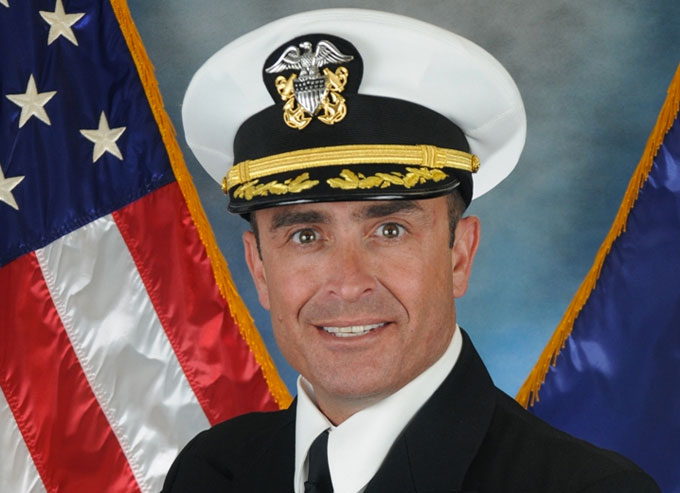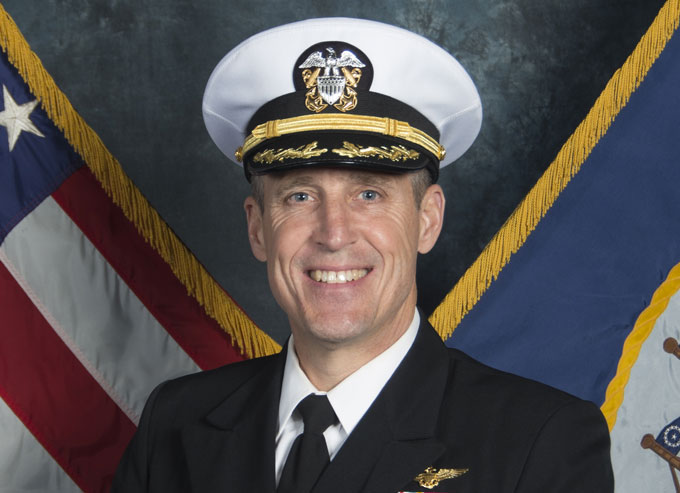
The crew of the USS Bunker Hill (CG 52) puts their training and skills to the test each day as the integrated air and missile defense asset for the Theodore Roosevelt Carrier Strike Group (TRCSG) currently underway in the U.S. 5th Fleet area of operations.
One officer who stands out on the team is Chief Warrant Officer 3 Troy Woods, an Integrated Air and Missile Defense (IAMD) Warfare Tactics Instructor (WTI).
Woods earned his red-and-black WTI patch after completing the IAMD Warfare Tactics Instructor Course at Naval Surface and Mine Warfighting Development Center’s (SMWDC) IAMD Division in Dahlgren, Virginia.
Woods also completed a production tour at the Center for Surface Combat Systems (CSCS) where he cemented the training that SMWDC provides with additional practical application.
(U.S. Navy Warfare Tactics Instructor (WTI) Bring The Sword Back To The Sea – 2017. Courtesy of MILITARY STUFF and YouTube)
Production tours are a WTI’s opportunity to immediately bring their training and expertise to the waterfront in a meaningful way and typically follow graduation from the WTI course of instruction.
“The purpose of the WTI program is to train junior officers at a high level, so they can return to the fleet and be exceptional teammates who improve the capability of our warships to fight and win,” said Woods, who is also the first warrant officer to earn a patch.
A WTI’s responsibility doesn’t end when they get their patch. That’s really just the beginning.”
Woods is just one of a group of over 20 WTIs who are returning to the fleet after completing their production tours and the influence they are having has been noticed by leadership.
(Learn More. Courtesy of the Naval Surface Force U.S. Pacific Fleet and YouTube)
“Fortunately, I have a commanding officer who is a plank owner,” Woods said.
“So he integrates me into our team’s warfare planning cells as well as standing my tactical watch.”
The value Woods brings to Bunker Hill is closely linked to the wealth of information and experiences that SMWDC’s WTI program provides to junior officers interested in tactics and warfighting.
It truly exemplifies SMWDC’s motto: “Tactical Excellence by Design.”
(What are the three Warfare Tactics Instructor programs? Courtesy of the Naval Surface Force U.S. Pacific Fleet and YouTube)
“This is quite simply about our ability to fight and win. We are investing in the expertise of our surface warfare officers,” said Capt. Joe Cahill, Bunker Hill’s commanding officer.

“The program is on track and we’re beginning to see WTIs populate throughout the fleet.”
“We’re lucky to have two WTIs on our team – CWO3 Woods and Lt. Mize – who are both great examples of that ‘investment’ in expertise.”
“The investment in tactics, talent and training that WTIs represent is significant, lasting and has already made us better warfighters.”
But even the most seasoned warfighter can be surprised by the arduous nature of the WTI course of instruction.
(Why do you love being a Warfare Tactics Instructor? Courtesy of the Naval Surface Force U.S. Pacific Fleet and YouTube)
“For a guy like me, someone who served as a senior chief doing missile defense with forward-deployed Naval forces, some of the pipeline was a refresher,” said Woods.
“That doesn’t mean it was easy. After the first test, I had to eat a big slice of humble pie. It was a serious course.”
The warfighting system expertise and combat capability that WTIs bring to a shipboard watch team is an important force multiplier for strike group operations, as well.
While Woods is an air defense expert for the ship, he also writes weapons doctrine for TRCSG, which is a key factor in operations in the Arabian Gulf – integrating unit-level capabilities to maximize the effectiveness of carrier strike group operations.
(Will the surface warfare Navy support the Warfare Tactics Instructor program long term? Courtesy of the Naval Surface Force U.S. Pacific Fleet and YouTube)
“The U.S. Navy carrier strike group is the most versatile, capable force at sea,” said Rear Adm. Steve Koehler, commander, CSG-9.

“The development of the WTI program in the surface community was an important step to increasing lethality and tactical proficiency at the unit and strike group level, enabling forward deployed forces to carry out our nation’s tasking.”
“Our Strike Group is already seeing the impact of the program only two short years after SMWDC was established.”
SMWDC designates three-types of WTIs through three of its four divisions in either California or Virginia.
Amphibious Warfare (AMW) WTIs are trained at SMWDC’s AMW Division in Little Creek, Virginia.; Anti-Submarine Warfare/Surface Warfare WTIs (ASW/SUW) are trained at SMWDC’s Sea Combat Division in San Diego; and Integrated Air and Missile Defense (IAMD) WTIs are trained at SMWDC’s IAMD Division in Dahlgren, Virginia.
WTIs are a core component of SMWDC’s mission to increase the lethality and tactical proficiency of Naval Surface Forces across Sea Control and Power Projection missions.
(How do I sign up to become a Warfare Tactics Instructor? Courtesy of the Naval Surface Force U.S. Pacific Fleet and YouTube)
They provide direct support to SMWDC’s four lines of operation: advanced tactical training, doctrine and tactical guidance development, operational support and capability assessments, experimentation and future requirements.
Bunker Hill is currently operating forward, visible and ready with the TRCSG in the U.S. 5th Fleet area of operations in support of maritime security operations to reassure allies and partners and preserve the freedom of navigation and the free flow of commerce in the region.
TRCSG is comprised of Carrier Strike Group 9 staff, Destroyer Squadron (DESRON) 23 staff, USS Theodore Roosevelt (CVN 71), Carrier Air Wing (CVW) 17 and the DESRON-23 ships: the guided-missile destroyers USS Halsey (DDG 97), USS Higgins (DDG 76), USS Preble (DDG 88) and USS Sampson (DDG 102), as well as Bunker Hill.
 For more information, visit www.navy.mil, www.facebook.com/usnavy or www.twitter.com/usnavy.
For more information, visit www.navy.mil, www.facebook.com/usnavy or www.twitter.com/usnavy.
For more news from USS Theodore Roosevelt (CVN 71), visit www.navy.mil/local/cvn71/.
















